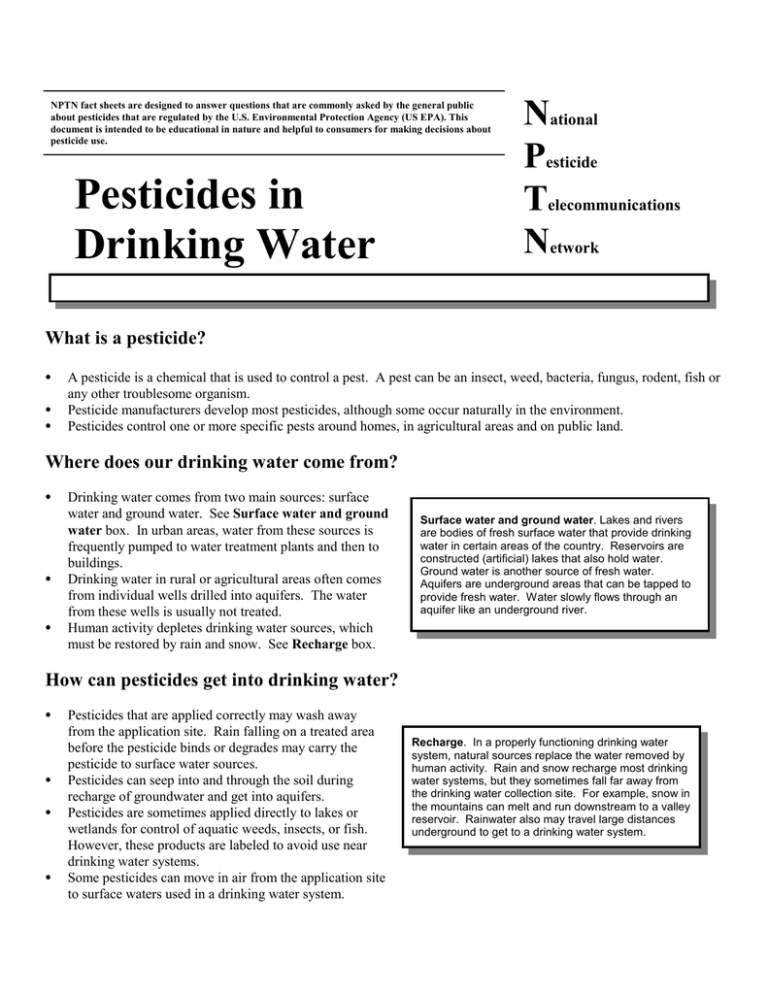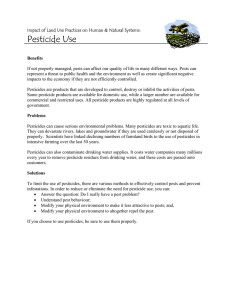N
advertisement

NPTN fact sheets are designed to answer questions that are commonly asked by the general public about pesticides that are regulated by the U.S. Environmental Protection Agency (US EPA). This document is intended to be educational in nature and helpful to consumers for making decisions about pesticide use. Pesticides in Drinking Water National Pesticide Telecommunications Network What is a pesticide? C C C A pesticide is a chemical that is used to control a pest. A pest can be an insect, weed, bacteria, fungus, rodent, fish or any other troublesome organism. Pesticide manufacturers develop most pesticides, although some occur naturally in the environment. Pesticides control one or more specific pests around homes, in agricultural areas and on public land. Where does our drinking water come from? C C C Drinking water comes from two main sources: surface water and ground water. See Surface water and ground water box. In urban areas, water from these sources is frequently pumped to water treatment plants and then to buildings. Drinking water in rural or agricultural areas often comes from individual wells drilled into aquifers. The water from these wells is usually not treated. Human activity depletes drinking water sources, which must be restored by rain and snow. See Recharge box. Surface water and ground water. Lakes and rivers are bodies of fresh surface water that provide drinking water in certain areas of the country. Reservoirs are constructed (artificial) lakes that also hold water. Ground water is another source of fresh water. Aquifers are underground areas that can be tapped to provide fresh water. Water slowly flows through an aquifer like an underground river. How can pesticides get into drinking water? C C C C Pesticides that are applied correctly may wash away from the application site. Rain falling on a treated area before the pesticide binds or degrades may carry the pesticide to surface water sources. Pesticides can seep into and through the soil during recharge of groundwater and get into aquifers. Pesticides are sometimes applied directly to lakes or wetlands for control of aquatic weeds, insects, or fish. However, these products are labeled to avoid use near drinking water systems. Some pesticides can move in air from the application site to surface waters used in a drinking water system. Recharge. In a properly functioning drinking water system, natural sources replace the water removed by human activity. Rain and snow recharge most drinking water systems, but they sometimes fall far away from the drinking water collection site. For example, snow in the mountains can melt and run downstream to a valley reservoir. Rainwater also may travel large distances underground to get to a drinking water system. C C C When a pesticide is spilled, dumped, or misused, the chance of it reaching drinking water is greater than with labeled uses. Pesticides can get into drinking water when homeowners illegally dump unused pesticides down the drain. For instructions on proper disposal of pesticides contact your County Cooperative Extension Office or State Environmental Department. In water treatment plants, disinfectant pesticides are intentionally put in drinking water to help protect humans from disease-causing organisms such as bacteria and viruses. See Antimicrobials box. Antimicrobials. The Safe Drinking Water Act requires that public water supplies be disinfected. Antimicrobial pesticides are added during the process of drinking water treatment to prevent waterborne disease. Chlorine is the most common and cost effective antimicrobial used. However, this process can produce chemical by-products, some of which may have toxic effects. The EPA is responsible for setting drinking water treatment standards to ensure that human health is protected. They must balance the risks from microbial contaminants against risks from disinfectants and disinfection by-products. Which pesticides are commonly found in drinking water? C C C C Pesticides used in the recharge zone might be found in drinking water. For example, drinking water in an agricultural area may contain pesticides that were sprayed on agricultural crops. Pesticides with certain chemical characteristics, such as high water solubility, are more likely to be found in drinking water. If pesticides are spilled or misused near a well, they can get into drinking water. Certain antimicrobial pesticides are common in drinking water that has come from a public source (municipal water). How do I know if pesticides are in my drinking water? C C C Officials regularly test the public water supplies (municipal water) for certain pesticides. Information on these tests is available from your local water company. If you get water from a well, you can contact your County Health Department or State Environmental Department to inquire if pesticides have been found in wells in your area. The only way to know if a pesticide is present in your drinking water is to have your water tested. Unfortunately, testing can be costly. Can pesticides in drinking water cause health effects ? C C C Pesticides found in drinking water may be harmful to Dose-response. Pesticides can affect human health your health. The toxicity of pesticides and the amount and the environment depending on how much chemical detected determine if any health effects are likely. See is present, the length and frequency of exposure, and Dose Response box. the toxicity of the pesticide. Effects also depend on the Individual pesticides have different effects on humans. health of a person and the condition of the environment when exposure occurs. Laboratories can detect Variation exists in the toxicity of pesticides and the extremely low levels of pesticides in drinking water that sensitivity of people to chemicals. In large amounts, are unlikely to be harmful to humans. some pesticides can cause long-term health effects, such as cancer or organ damage, in laboratory animals. Some pesticides at high doses can cause reproductive effects in laboratory animals. Most pesticides will have toxic effects on animals at high levels. Some pesticides are toxic at medium or low levels. Pesticides in drinking water are usually found at very low levels. C C For many pesticides, scientists have determined levels that are not likely to pose health risks. See Maximum Contaminant Level box. When pesticides in drinking water are above acceptable levels, you should take measures to avoid drinking it. What do I do if pesticides are found in my drinking water? C C C C Maximum Contaminant Level (MCL). The United States Environmental Protection Agency (EPA) has set specific maximum levels of certain pesticides that are allowed in drinking water. These levels are based on scientific data from long term animal studies and have an additional safety factor built in. By drinking water that contains pesticide at or less than the MCL, humans are not expected to be at a higher risk for health problems. The EPA has also established health advisory levels (HA’s) for many pesticides. HA’s are non-enforceable guideline levels for contaminants that are in place until it is determined that there is a need to establish an MCL. If a pesticide is found in your drinking water above acceptable levels, you should report this to your State Department of Agriculture. If you are having health effects you suspect are linked to pesticide exposure, consult a physician or contact the National Pesticide Telecommunications Network (NPTN). Drinking water contaminated with pesticides can be treated by a local water treatment facility to remove most of the pesticides. Activated carbon or reverse osmosis filters can be effective at removing pesticides from water. Consult your EPA Regional Office for the most effective treatment method for the pesticide(s) of concern. Contaminated wells can sometimes be dug deeper to avoid pesticides. Note: This may not always solve the problem. Consult a professional engineer. Using bottled water can be an alternative if your water is contaminated until you can take measures to correct the problem. Note: Bottled water is not always regulated for pesticides. What is being done about pesticides in drinking water? C C C C Several government agencies including the U.S. EPA Office of Water, U.S. Geological Survey (USGS), and State Environmental Departments, and local city and county agencies monitor drinking water. Note: Drinking water is not tested in all areas. Contact these agencies for further information. Pesticide levels detected in water samples are compared to acceptable levels. If pesticides are found at higher than the acceptable levels, then agencies take action to correct the problem or notify affected citizens. The Safe Drinking Water Act is in place to reduce exposure to contaminants including pesticides in drinking water. Scientists are conducting research to better understand the long term effects of certain pesticides in drinking water. Further reading: 1. Drinking Water Regulations and Health Advisories. U.S. Environmental Protection Agency, Office of Water, U.S. Government Printing Office: Washington, DC, 1996. 2. Home Water Testing. U.S. Environmental Protection Agency, Office of Water, U.S. Government Printing Office: Washington, DC, 1991. 3. Is Your Drinking Water Safe? U.S. Environmental Protection Agency, Office of Water, U.S. Government Printing Office: Washington, DC, 1994. 4. National Primary Drinking Water Regulations Vols.1-3. U.S. Environmental Protection Agency, Office of Water, U.S. Government Printing Office: Washington, DC, 1995. 5. Pesticides in Drinking Water Wells. U.S. Environmental Protection Agency, Office of Prevention, Pesticides and Toxic Substances, U.S. Government Printing Office: Washington, DC, 1990. 6. Pesticide Movement to Water: Proceedings of a symposium organized by the British Crop Protection Council, in conjunction with the Society of Chemical Industry. Walker, A., Allen, R., Bailey, S. W., Blair, A. M., Brown, C. D., Gunther, P., Leake, C. R. & Nichols, P. H., Eds; British Crop Protection Council: Farnham, Surrey, UK, 1995. Date reviewed: July, 2000 For more information contact: NPTN Oregon State University, 333 Weniger Hall, Corvallis, Oregon 97331-6502. Phone: 1-800-858-7378 Fax: 1-541-737-0761 Email: nptn@ace.orst.edu NPTN at http://nptn.orst.edu/ EXTOXNET at http://ace.orst.edu/info/extoxnet/ Or: U.S. EPA Safe Drinking Water Hotline 401 M Street, SW # 4604, Washington, DC 20460 Copies of this factsheet are not available at this hotline. Phone: 1-800-426-4791 Fax: 1-703-285-1101 Email: hotline-sdwa@epamail.epa.gov U.S. EPA Office of Ground Water and Drinking Water at http://www.epa.gov/safewater/ NPTN is sponsored cooperatively by Oregon State University and the U.S. Environmental Protection Agency. Data presented through NPTN documents are based on selected authoritative and peer-reviewed literature. The information in this profile does not in any way replace or supersede the restrictions, precautions, directions or other information on the pesticide label/ing or other regulatory requirements.






